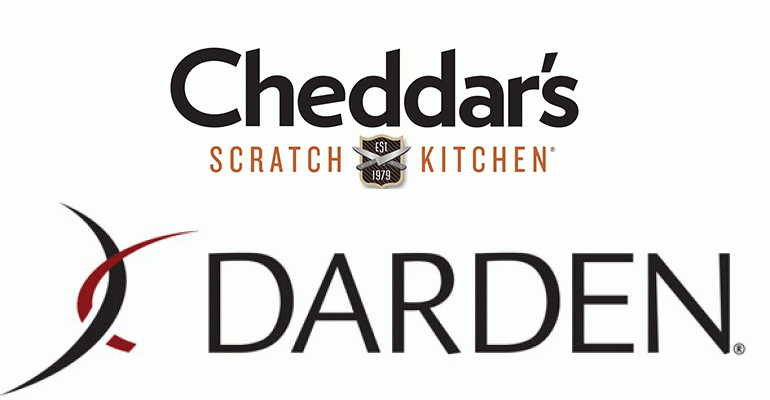Darden Restaurants Inc. got back in the acquisition game this week with a deal announced Monday to acquire Cheddar’s Scratch Kitchen for $780 million.
The Orlando, Fla.-based casual-dining operator has used several deals, from its $1.4 billion acquisition of RARE Hospitality in 2007, to its 2012 purchase of Yard House, to become a giant in the segment
That era seemingly ended in 2014, when Darden, beset by a shareholder uprising, sold Red Lobster, one of its biggest concepts. Then, in 2015, the company, with seven concepts at the time, spun off its real estate.
But with the Cheddar’s deal, Darden is again arguing that its business has been built to operate multiple brands, and that it could fit more concepts under its umbrella. Cheddar’s gives Darden its eighth brand, and potentially one of its two or three biggest concepts, assuming the chain meets growth targets, executives said.
Cheddar’s will also help Darden continue to grow at a time when growth is hard to come by.
“We enable brands to succeed in the market,” said CEO Gene Lee, who came to Darden as part of the 2007 RARE deal, on a conference call Tuesday. “We give them scale advantage. We give them data and insights. We help them with strategic planning. Our umbrella gives them unique operating cultures, yet have industry-leading retention numbers.”
Darden will pay $780 million for Cheddar’s, a multiple of more than 10 times the 165-unit chain’s cash flow in 2016. Darden will use a combination of debt and existing cash to acquire the chain from its private-equity owners, L Catterton and Oak Investment Partners.
In Cheddar’s, Darden will get a chain that generated $617 million in revenue last year, with cash flow margins of 17 percent. Its restaurants averaged $4.4 million in unit volumes, with an average check of $13.50.
Cheddar’s 2016 system sales were $731.3 million, up 2.4 percent, according to Nation’s Restaurant News Top 200 data. The system includes 25 franchised locations. Earlier this year, Cheddar’s acquired 44 restaurants from a franchisee.
Lee said that Cheddar’s shares a similar operating philosophy with Darden, as both companies focus on improving food, service and atmosphere. Cheddar’s also gives Darden a chain with a value-oriented, varied menu.
That’s something in a challenging market. Casual-dining concepts, particularly bar-and-grill chains with varied menus, such as Applebee’s, Chili’s and Ruby Tuesday, have struggled for years. But Lee said Cheddar’s is in a different category.
“We don’t consider Cheddar’s as a traditional, ubiquitous bar-and-grill,” Lee said. “It has a different menu, a totally different footprint. It’s broadly appealing. We see Cheddar’s in a segment we’ve defined as places where brands are winning, like Cracker Barrel, Texas Roadhouse and Olive Garden.
“We don’t think of this as bar-and-grill. It’s almost the antithesis of bar-and-grill.”
Darden believes that Cheddar’s will give the company further opportunities for revenue growth. The chain’s restaurants are largely concentrated in the Southeast, and Lee said the brand has the potential to be its third largest — and potentially its second largest concept — after Olive Garden.
“This acquisition is the right next step for us as a brand,” said Ian Baines, who will remain as Cheddar’s brand president after the deal is complete this spring.
Darden is a behemoth, whose brands generate about $7 billion in revenue per year, across more than 1,500 total locations, including 843-unit Olive Garden.
“We will benefit from the support structure and their expertise in developing new brands,” Baines said. “It will open up new opportunities previously out of our reach.”
Although Darden has size, revenue this year has grown just 1.8 percent so far in the company’s 2017 fiscal year, including 1.7 percent, to nearly $1.9 billion, in the third quarter ended Feb. 26.
In February, KeyBanc Capital Markets analyst Chris O’Cull wrote that Darden’s long-term goal is to generate 2-percent to 3-percent in sales growth from new units, “which it has struggled to achieve the last 12 months.” Cheddar’s should help speed revenue growth.
Plus, the casual-dining segment is highly developed, and finding sites has grown difficult.
“It’s getting harder and harder to find locations where we can get that return, because of cannibalization and other factors,” Lee said.
“This is a mature industry,” Lee added. “Some consolidation makes sense. That’s what we’re trying to do. If we get a little more scale, we can improve our supply chain; we can improve our use of data and insights. By plugging into the Darden platform, our brands have advantages in the marketplace. They can underprice our competitors and take market share.”
So why can Darden add brands now, when the company was shedding brands just three years ago? Lee said the company is different today.
“We’re much more decentralized today than” in 2007, he said.
“The decisions made then, they were going to build more capabilities in the center. They made investments in [general and administrative functions] to grow the business,” Lee said. “We’re doing it the exact opposite. We’re letting the presidents run the business. We’re focused on where we can get synergies in the middle on non-consumer facing areas.”
Contact Jonathan Maze at [email protected]
Follow him on Twitter: @jonathanmaze





